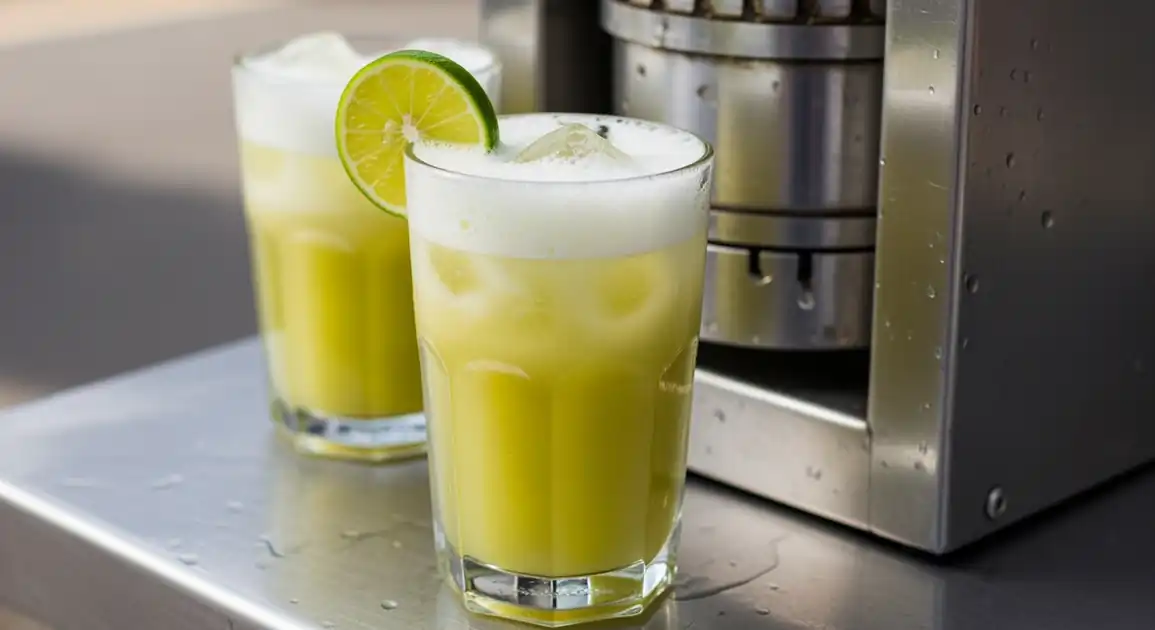Caldo de Cana (Sugarcane Juice)
Caldo de Cana / Garapa

Description
Caldo de Cana is ubiquitous throughout Brazil, found anywhere from major cities to small towns. It's particularly prominent at 'feiras livres' (street markets), roadside stalls, and sometimes in parks or near beaches. It's a year-round refreshment enjoyed by people of all ages.
Dietary Information
Serving information
Serving style
Served cold in a disposable plastic cup or sometimes a glass (at permanent stalls). Lime wedge often added. Best consumed immediately after pressing.
Quick facts
Typically daytime hours, aligning with market times (approx. 7 AM - 2 PM) or general street vending hours (approx. 9 AM - 6 PM).
Safety Tips
What to Look For
-
Juice pressed fresh to order ('na hora')
Ensures maximum freshness and minimizes time for bacterial growth or fermentation.
-
Clean pressing machine ('moenda')
Check for absence of dirt, grime, rust, mold, old cane residue, and insects, especially around rollers and collection spout.
-
Vendor uses clean cups and utensils
Cups should be new/clean. Observe handling practices to avoid contamination.
-
Vendor washes hands or uses clean practices
Basic hygiene is crucial when handling food/drinks.
-
Optional: Juice is strained through a clean filter
Removes small cane fibers, improving texture and possibly removing some contaminants.
-
Optional: Ice looks clear and commercially made (if using)
Cloudy or block ice might be from questionable water sources. 'Sem gelo' (no ice) is the safest option if unsure.
What to avoid
-
Pre-pressed juice stored in jugs or containers
Juice degrades quickly. Pre-pressed juice has higher risk of fermentation and contamination.
-
Visibly dirty 'moenda' machine or surrounding area
Clear sign of poor hygiene standards. Avoid vendors with flies buzzing around the machine.
-
Re-used or dirty-looking cups
Obvious hygiene risk.
-
Vendor handles money and then juice/cups without cleaning hands
Risk of cross-contamination.
-
Juice with a sour or fermented smell
Indicates the juice is old or starting to spoil.
Price information
Price range
Budget tips
- Prices are generally lowest at 'feiras livres'.
- Street corner vendors are usually cheaper than established juice bars or beach kiosks.
- Prices vary by size (usually 300ml, 500ml, 700ml, 1L).
Value indicators
- Freshly pressed on demand.
- Cleanliness of the vendor's setup.
- Option for fresh lime included.
- Served chilled (naturally or with safe ice).
Where to Find This Dish
Feiras Livres (Street Markets)
Found in nearly every neighborhood weekly market across Brazil. The classic place to find it.
Designated market streets (varies by neighborhood/day)
Morning (typically 7 AM - 1 PM)
Street Corners / Busy Roadsides
Standalone stalls with 'moendas' are common in areas with high foot traffic.
Busy intersections, Near bus stops
Daytime
Parks and Public Squares
Vendors often set up in or near recreational areas.
Local parks ('praças')
Daytime, especially weekends
Vendor Tips
- Look for the 'moenda' (press machine) as the key identifier.
- Always ask for 'com limão' for the best flavor balance.
- Observe the pressing process to ensure freshness and cleanliness.
- Have small change available (BRL 5, 10 notes or coins).
How to Order
Regional Variations
-
Caldo de Cana Puro
(Caldo de Cana Puro)
Plain, freshly squeezed sugarcane juice.
-
Caldo de Cana com Limão
(Caldo de Cana com Limão)
The most popular variation, with fresh lime or lemon juice squeezed in to balance the sweetness. Highly recommended.
-
Caldo de Cana com Gelo
(Caldo de Cana com Gelo)
Served with ice cubes. Common, but consider ice source safety.
-
Caldo de Cana com Abacaxi
(Caldo de Cana com Abacaxi)
Sugarcane juice blended with fresh pineapple. More common in juice bars ('casas de suco') than street stalls.
-
Caldo de Cana com Gengibre
(Caldo de Cana com Gengibre)
Sugarcane juice blended or infused with ginger. Offers a spicy kick. Also more typical of juice bars.
Cultural context
History
Sugarcane cultivation has been central to Brazil's economy and history since the colonial era. Caldo de Cana emerged as a simple, accessible way for people to consume a product of this abundant crop. It became a widespread, affordable source of quick energy and refreshment for workers and the general population. Its presence, particularly alongside pastel at 'feiras livres', is a deeply ingrained cultural tradition.
Local significance
A quintessential Brazilian refreshment, deeply tied to the country's agricultural heritage (sugarcane). Represents simple, natural pleasure.
Eating customs
- Consumed immediately after pressing for best flavor and freshness.
- Often drunk standing near the vendor's stall.
- The lime is usually squeezed in by the vendor or provided for the customer to add.